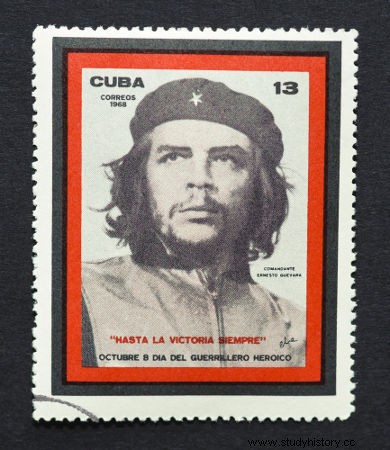
The Cuban Revolution was a revolutionary process responsible for the overthrow of the dictatorial government imposed by Fulgêncio Batista which resulted in the taking of power by the guerrillas led by Fidel Castro in 1959. Although, at first, it was not based on a socialist ideology, the Cuban movement ended up aligning itself with Soviet communism .
Fulgencio Batista Coup
Cuba became independent in 1898, from US support against Spain, and since then it has become a kind of US backyard, where countless US businesses developed with very high profits at the expense of exploiting the Cuban economy. The opposition process against power in Cuba began with the coup carried out by Fulgencio Batista, on March 10, 1952, which resulted in the overthrow of then President Carlos Prío Socarrás. After the coup, Fulgencio Batista established a strong military dictatorship with strong repression of the press and of any political opposition movement and with it began the fight of Fidel Castro and his supporters. We can say, therefore, that the movement led by Fidel Castro is, at the same time, a struggle against the dictatorship of Fulgencio Batista and also a nationalist struggle against US interventions in Cuban affairs, both in political and economic matters.
Fight Start
The fight against Fulgencio Batista began in 1953, when the attack on the Moncada Barracks, in the city of Santiago, on July 26 was organized. The objective of the attack was to carry out the seizure of arms, but the attack was a failure and Fidel Castro and his brother were arrested. Fidel Castro was sentenced to 15 years in prison, however, two years later, in 1955, he was amnestied (pardoned) by Fulgencio Batista due to public pressure on Batista. Fidel and his brother went into exile in Mexico and from there they reorganized the movement in order to return to Cuba to overthrow Fulgencio Batista.
In Mexico, Fidel Castro organized a group of 81 men and among them were Raúl Castro, Ernesto “Che” Guevara and Camilo Cienfuegos, who returned to the island of Cuba in 1956 and in December of the same year they suffered an attack by the Cuban army and were defeated. After the defeat, the survivors fled and hid in the Sierra Maestra region and, from there, they reorganized and started to act in guerrilla tactics, carrying out small attacks on the Cuban army troops that, little by little, were demoralizing the government. of Fulgencio Batista and gaining more and more sympathizers. On Fulgencio's defeat:
“Fidel won because the Batista regime was fragile, had no real support other than convenience and self-interest, and it was led by a man rendered indolent by long corruption. It collapsed as soon as the opposition of all political classes, from the democratic bourgeoisie to the communists, united against him, and the soldiers, police and torturers themselves concluded that his time was up” 1
Defeated, Fulgencio Batista fled and went into exile in the Dominican Republic on January 1, 1959.
New Cuban government and Cold War
Shortly after the defeat, Fidel Castro called himself prime minister and little by little he began to concentrate his power on himself. Some of the initial measures taken by the new government were:it carried out agrarian reform, ending the large estates on the island, and nationalized foreign companies, directly affecting the interests of the United States on the island.
In January 1961, the United States broke diplomatic relations with Cuba and, in April of the same year, a counterrevolutionary attack with the support of the CIA was carried out against the Castro government in Bay of Pigs Invasion . Fidel Castro's troops managed to neutralize the attack, but Fidel Castro aligned Cuba with the Soviet Union, declaring Cuba a socialist nation. About that:
“In fact, the Cuban revolution was indigenous, had a national and democratic character, and the establishment of a regime modeled on the countries Eastern Europe resulted from a historical contingency, not from a policy undertaken by the Soviet Union, but undertaken by the United States, which, without respecting the principles of national sovereignty and self-determination of the peoples, did not accept the acts of revolution, such as agrarian reform. , and turned contradictions of national interests into an East-West conflict problem.” 2
From Cuba's alignment to the socialist model, a series of interventions were carried out in education and health, which are currently considered references, but the Cuban model is also criticized for the lack of freedom of expression and the conditions of poverty to which the Cuban population is currently subjected. After the alignment with the Soviet model, Cuba was also the scene of one of the greatest tensions of the period known as the Missile Crisis, where the installation of Soviet missile bases in Cuba were discovered, generating a diplomatic conflict between the United States and the Soviet Union that was resolved after negotiations.
*Image Credits:Catwalker and Shutterstock
Notes:
1 HOBSBAWN, Eric. The Age of Extremes:The Brief Twentieth Century (1914-1991). São Paulo:Companhia das Letras, 1995, p. 426.
2 BANDEIRA, Luiz Alberto Moniz. Fidel Castro, the Cuban Revolution and Latin America. Accessed at:https://www.espacoacademico.com.br/082/82bandeira.pdf, on 02/14 at 7:15 am.
